(完整版)英语动词不定式大全
- 格式:doc
- 大小:26.51 KB
- 文档页数:4

(语态)动词和参与此动作的主语之间关系的一个术语。
当主语是动作的发起者(或之一)时,称为主动语态;如果动词不定式的逻辑主语是这个不定式所表示的动作的承受者,不定式一般要用被动语态形式。
如:It's a great honour to be invited to Mary's birthday party.(不定式作主语是被动语态to be invited是被邀请)It was impossible for lost time to be made up.(不定式作主语)I wish to be sent to work in the country.(不定式作宾语)Can you tell me which is the car to be repaired?(不定式作定语)He went to the hospital to be examined.(不定式作状语)My work is to clean the room every day.(不定式作表语)在There be结构中,修饰主语的不定式可用被动,也可用主动。
如:There are still many things to take care of (to be taken care of).但有时两种形式表达的意思不同,如:There is nothing to do now.( We have nothing to do now.) There is nothing to be done now.(We can do nothing now.)形式1) 现在式:一般现在时表示的动词,有时与谓语动词表示的动作同时发生,有时发生在谓语动词的动作之后。
一般为:动词+ to do sthHe seems to know this.I hope to see you again. = I hope that I'll see you again. 我希望再见到你。
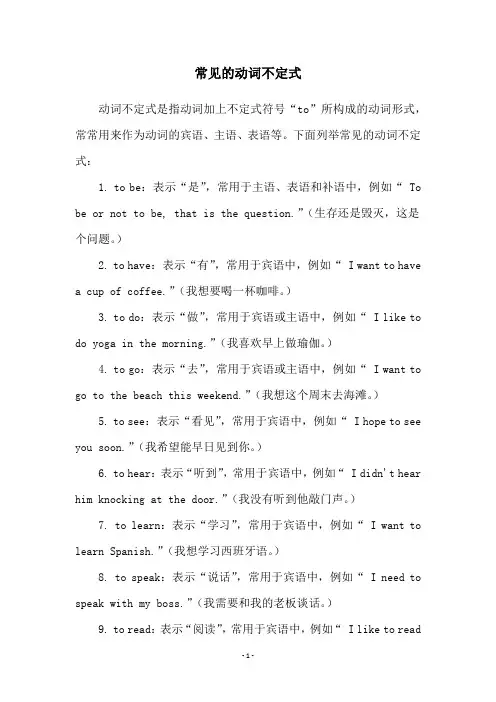
常见的动词不定式动词不定式是指动词加上不定式符号“to”所构成的动词形式,常常用来作为动词的宾语、主语、表语等。
下面列举常见的动词不定式:1. to be:表示“是”,常用于主语、表语和补语中,例如“ To be or not to be, that is the question.”(生存还是毁灭,这是个问题。
)2. to have:表示“有”,常用于宾语中,例如“ I want to havea cup of coffee.”(我想要喝一杯咖啡。
)3. to do:表示“做”,常用于宾语或主语中,例如“ I like to do yoga in the morning.”(我喜欢早上做瑜伽。
)4. to go:表示“去”,常用于宾语或主语中,例如“ I want to go to the beach this weekend.”(我想这个周末去海滩。
)5. to see:表示“看见”,常用于宾语中,例如“ I hope to see you soon.”(我希望能早日见到你。
)6. to hear:表示“听到”,常用于宾语中,例如“ I didn't hear him knocking at the door.”(我没有听到他敲门声。
)7. to learn:表示“学习”,常用于宾语中,例如“ I want to learn Spanish.”(我想学习西班牙语。
)8. to speak:表示“说话”,常用于宾语中,例如“ I need to speak with my boss.”(我需要和我的老板谈话。
)9. to read:表示“阅读”,常用于宾语中,例如“ I like to readbooks in my free time.”(我喜欢在空闲时间读书。
)10. to write:表示“写作”,常用于宾语中,例如“ I need to write a report for my boss.”(我需要为我的老板写一份报告。
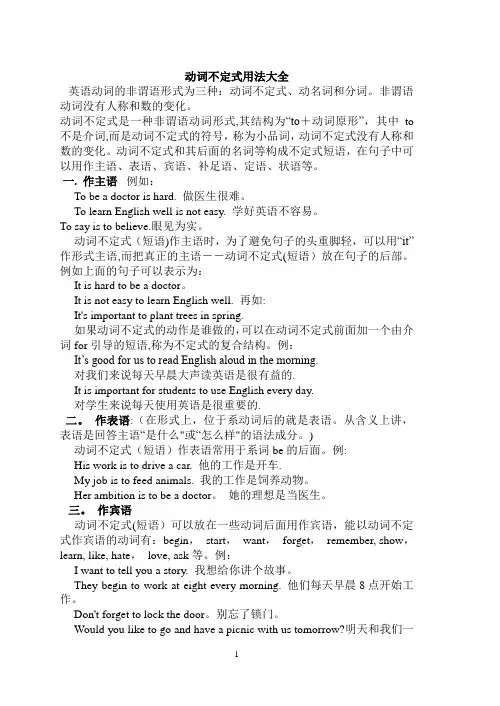
动词不定式用法大全英语动词的非谓语形式为三种:动词不定式、动名词和分词。
非谓语动词没有人称和数的变化。
动词不定式是一种非谓语动词形式,其结构为“to+动词原形”,其中to 不是介词,而是动词不定式的符号,称为小品词,动词不定式没有人称和数的变化。
动词不定式和其后面的名词等构成不定式短语,在句子中可以用作主语、表语、宾语、补足语、定语、状语等。
一. 作主语例如:To be a doctor is hard. 做医生很难。
To learn English well is not easy. 学好英语不容易。
To say is to believe.眼见为实。
动词不定式(短语)作主语时,为了避免句子的头重脚轻,可以用“it”作形式主语,而把真正的主语--动词不定式(短语)放在句子的后部。
例如上面的句子可以表示为:It is hard to be a doctor。
It is not easy to learn English well. 再如:It's important to plant trees in spring.如果动词不定式的动作是谁做的,可以在动词不定式前面加一个由介词for引导的短语,称为不定式的复合结构。
例:It’s good for us to read English aloud in the morning.对我们来说每天早晨大声读英语是很有益的.It is important for students to use English every day.对学生来说每天使用英语是很重要的.二。
作表语:(在形式上,位于系动词后的就是表语。
从含义上讲,表语是回答主语“是什么"或“怎么样"的语法成分。
)动词不定式(短语)作表语常用于系词be的后面。
例:His work is to drive a car. 他的工作是开车.My job is to feed animals. 我的工作是饲养动物。

带to的动词不定式常见搭配:希望做某事hope to do sth. 决定做某事decide to do sth. 同意做某事agree to do sth.需要某人做某事need to do sth 使用某物做某事use sth to do sth迫不及待做某事can’t wait to do 准备做某事get/be ready to do 尽力/努力做某事try to do sth .计划做某事plan to do sth. 不得不have to do 轮流做某事tak e one’s turns to do sth.拒绝做某事refuse to do sth.告诉某人做某事tell sb. to do sth.请某人做某事ask sb. to do sth.希望某人做某事wish sb. to do sth. .教某人做某事teach sb. to do sth想要某人做某事want /would like sb.to do sth.同意某人做某事agree sb. to do sth. .喜欢/想要某人做某事like sb. to do sth. 帮助某人做某事help sb. to do sth/help sb.do鼓励某人做encourage sb to do轮到某人做某事It’s one’s turn to do sth.是某人做某事时候了It’s time(for sb.)to do sth.对于某人来说做某事是…(当adj.是表示性格、品德的形容词时用of It’s +adj.+for/of sb. to do sth. 某人做某事花了时间 It takes sb. sometime to do sth 太…..而不能 too+adj./adv. to do sth. 发现/感到做某事是…find/ feel it +adj.to do sth忘记/记得去做某事forget/remember to do sth be+adj+to do sth二以下是不带to的动词不定式(即动词原形)的常见用法let sb. do sth让某人做某事 .make do sth使得某人做某事hear do sth do sth听见某人做某事see do sth do sth看见某人做某事why not/why don’t you +V动原为什么不….?表示建议某人+had better( not)do 某人最好(不)做某事情态动词can/may /must /should+ 动词原形(包括情态动词的否定形式+动词原形)助动词do/does/did/will/would在构成疑问句/否定句don’t/doesn’t /didn’t /will not /would not+ 动词原形be going to + 动词原形(表示“即将”“打算” 做某事).在以下结构中1.enjoy doing sth 喜欢做某事2.finish doing sth;完成做某事;3.feel like doing sth 想要做某事;4.stop doing sth 停止做某事(原来的事)5.forget doing sth 忘记做过某事;6.go on doing sth 继续做某事(原来的事);7.remember doing sth 记得做过某事;8.like doing sth 喜欢做某事;9.find/see/hear/watch sb doing 发现/看到/听到/观看某人做某事10.try doing sth 试图做某事; 11.need doing sth 需要做某事;12.prefer doing sth 宁愿做某事;13.mind doing sth 介意做某事;14.miss doing sth 错过做某事; 15.practice doing sth 练习做某事;16.be busy doing sth 忙于做某事; 17.can't help doing sth 禁不住做某事;18. waste time/money doing 浪费时间/金钱做…; 19. keep sb.doing 让…始终/一直做…20. stop sb.(from)doing 阻止某人做某事21. prefer doing B to doing A 比起做A更喜欢做B22. “do some +doing”短语Eg:do some shopping/do some washing/do some reading/do some practicing/ do some cleaning/do some speaking 23.“go doing”短语去做某事(主要指文娱活动等)Eg:go shopping/go fishing/go swimming/ go hiking/go skating/go camping。
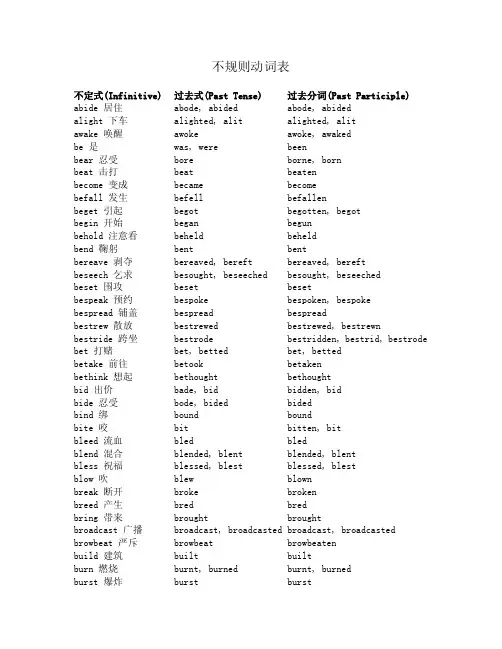
不规则动词表不定式(Infinitive) 过去式(Past Tense) 过去分词(Past Participle) abide 居住abode, abided abode, abidedalight 下车alighted, alit alighted, alitawake 唤醒awoke awoke, awakedbe 是was, were beenbear 忍受bore borne, bornbeat 击打beat beatenbecome 变成became becomebefall 发生befell befallenbeget 引起begot begotten, begotbegin 开始began begunbehold 注意看beheld beheldbend 鞠躬bent bentbereave 剥夺bereaved, bereft bereaved, bereftbeseech 乞求besought, beseeched besought, beseechedbeset 围攻beset besetbespeak 预约bespoke bespoken, bespokebespread 铺盖bespread bespreadbestrew 散放bestrewed bestrewed, bestrewnbestride 跨坐bestrode bestridden, bestrid, bestrode bet 打赌bet, betted bet, bettedbetake 前往betook betakenbethink 想起bethought bethoughtbid 出价bade, bid bidden, bidbide 忍受bode, bided bidedbind 绑bound boundbite 咬bit bitten, bitbleed 流血bled bledblend 混合blended, blent blended, blentbless 祝福blessed, blest blessed, blestblow 吹blew blownbreak 断开broke brokenbreed 产生bred bredbring 带来brought broughtbroadcast 广播broadcast, broadcasted broadcast, broadcasted browbeat 严斥browbeat browbeatenbuild 建筑built builtburn 燃烧burnt, burned burnt, burnedburst 爆炸burst burstbuy 买bought boughtcan 能could -cast 铸造cast castcatch 抓住caught caughtchide 责骂chid, chided chid, chidden, chided choose 选择chose chosencleave:分裂cleaved, cleft, clove cleaved, cleft打通clave clovencling 粘附clung clungclothe 穿衣clothed, clad clothed, cladcome 来came comecost 价值cost costcreep 爬行crept creptcrow 报晓crowed, crew crowedcut 切cut cutdare 敢dared, durst dareddeal 处理dealt dealtdig 挖洞dug dugdispread 扩散dispread dispreaddo 做did donedraw 画drew drawndream 做梦dreamed, dreamt dreamed, dreamtdrink 喝drank drunkdrive 驾车drove drivendwell 细想dwelt, dwelled dwelt, dwelledeat 吃ate eatenfall 落下fell fallenfeed 喂fed fedfeel 感觉felt feltfight 打架fought foughtfind 找寻found foundflee 逃跑fled fledfling 派出flung flungfly:飞flew flown逃逸fled fled击飞flied fliedforbear 克制forbore forborneforbid 禁止forbade, forbad forbiddenforecast 预报forecast, forecasted forecast, forecastedfordo 损毁fordid fordoneforego 居先forewent foregoneforeknow 预知foreknew foreknownforerun 作先驱foreran forerunforesee 看穿foresaw foreseenforeshow 预示foreshowed foreshownforetell 预言foretold foretoldforget 忘记forgot forgotten, forgot forgive 原谅forgave forgivenforsake 抛弃forsook forsakenforswear 发假誓forswore forswornfreeze 冷冻froze frozengainsay 反驳gainsaid gainsaidget 得到got got, gottengild 镀金gilded, gilt gildedgird 束缚girded, girt girded, girtgive 给予gave givengo 去went gonegrave 铭记graved graven, gravedgrind 磨ground groundgrow 成长grew grownhamstring 残废hamstringed, hamstrung hamstringed, hamstrung hang:挂hung hung吊死hanged hangedhave 有had hadhear 听heard heardheave 力擎heaved, hove heaved, hovehew 砍劈hewed hewed, hewnhide 隐藏hid hidden, hidhit 打hit hithold 拿住held heldhurt 伤害hurt hurtinlay 镶嵌inlaid inlaidkeep 保持kept keptkneel 下跪knelt, kneeled knelt, kneeledknit 编结knitted, knit knitted, knitknow 知道knew knownlade 舀水laded laded, ladenlay 放置laid laidlead 带领led ledlean 倾斜leaned, leant leaned, leant leap 跳跃leapt, leaped leapt, leaped learn 学习learnt, learned learnt, learned leave 离开left leftlend 借出lent lentlet 让let letlie:躺下lay lain撒谎lied liedlight:点燃lit lit照亮lighted lightedlose 丢失lost lostmake 做made mademay 可以might -mean 意思meant meantmeet 见面met metmelt 熔化melted melted, melten misdeal 处理不当misdealt misdealtmisgive 担忧misgave misgivenmislay 放错mislaid mislaidmislead 欺骗misled misledmistake 弄错mistook mistaken misunderstand 误会misunderstood misunderstood mow 割草mowed mowed, mownmust 必须must -ought 应该ought -outbid 中标outbade, outbid outbidden, outbid outbreed 超产outbred outbredoutdo 胜过outdid outdoneouteat 多吃outate outeatenoutfight 击败outfought outfoughtoutgo 支出outwent outgoneoutgrow 生长快outgrew outgrownoutlay 花费outlaid outlaidoutride 冲过outrode outriddenoutrun 超越outran outrunoutsell 畅销outsold outsoldoutshine 亮过outshone outshoneoutshoot 发射outshot outshotoutsit 久坐outsat outsatoutspend 花钱过多outspent outspentoutspread 伸展outspread outspreadoutthrow 扔出outthrew outthrownoutthrust 刺穿outthrust outthrustoutwear 用旧outwore outwornoverbear 压抑overbore overborneoverbid 漫天要价overbid overbidden, overbid overblow 吹过overblew overblownoverbuild 建造过多overbuilt overbuiltoverbuy 买得过贵overbought overboughtovercast 遮蔽overcast overcastovercome 克服overcame overcomeoverdo 做得过分overdid overdoneoverdraw 透支overdrew overdrawnoverdrive 超速overdrove overdrivenovereat 吃得太多overate overeatenoverfeed 喂得太多overfed overfedoverfly 飞过overflew overflownovergrow 过度生长overgrew overgrownoverhang 悬垂overhung overhungoverhear 无意听到overheard overheardoverlade 超载overladed overladed, overladen overlay 覆盖overlaid overlaidoverleap 跳过overleapt, overleaped overleapt, overleaped overlie 躺在上面overlay overlainoverpay 付出太多overpaid overpaidoverride 藐视overrode overriddenoverrun 泛滥overran overrunoversee 监督oversaw overseenoversell 卖完oversold oversoldoverset 推翻overset oversetoversew 缝合oversewed oversewed, oversewn overshoot 打过头overshot overshotoversleep 睡过头overslept oversleptoverspend 过度使用overspent overspentoverspread 扩张overspread overspreadovertake 追上overtook overtakenoverthrow 推倒overthrew overthrownoverwind 旋太紧overwound overwoundoverwrite 写得冗长overwrote overwrittenpartake 参与partook partakenpay 付出paid paidprecast 预计precast precast prechoose 预选prechose prechosenprove 证明proved proved, proven put 放put putquit 退出quitted, quit quitted, quit read 读read readreave 掠夺reaved, reft reaved, reft rebuild 重建rebuilt rebuiltrecast 重铸recast recastreeve 贯穿rove, reeved rove, reeved relay 转送relaid relaidrend 撕破rent rentrepay 报答repaid repaidreset 重设定reset resetretell 重述retold retoldrid 除去rid, ridded rid, riddedride 骑rode riddenring 响rang rungrise 升起rose risenrive 扯裂riven riven, rivedrun 跑ran runsaw 锯sawed sawn, sawedsay 说said saidsee 看见saw seenseek 搜索sought soughtsell 卖sold soldsend 送sent sentset 设置set setsew 缝补sewed sewn, sewed shake 摇晃shook shakenshall 将should -shave 剃须shaved shaved, shaven shear 修剪sheared shorn, sheared shed 脱落shed shedshine 照耀shone, shined shone, shined shoe 穿鞋shod, shoed shod, shoed shoot 射击shot shotshow 展示showed shown, showed shred 撕碎shredded, shred shredded, shred shrink 萎缩shrank, shrunk shrunk, shrunkenshrive 忏悔shrove, shrived shriven, shrived shut 关闭shut shutsing 唱歌sang, sung sungsink 下沉sank, sunk sunk, sunkensit 坐sat satslay 残杀slew slainsleep 睡觉slept sleptslide 滑动slid slid, slidden sling 吊起slung slungslink 潜逃slunk slunkslit 切开slit slitsmell 闻smelt, smelled smelt, smelled smite 打击smote smitten, smote sow 播种sowed sown, sowed speak 讲话spoke spokenspeed 促进sped, speeded sped, speeded spell 拼写spelt, spelled spelt, spelled spend 花钱spent spentspill 溢出spilt, spilled spilt, spilled spin 旋转spun spunspit 吐spat, spit spat, spitsplit 劈开split splitspoil 破坏spoilt, spoiled spoilt, spoiled spread 散布spread spreadspring 弹跳sprang, sprung sprungstand 站立stood stoodstave 凿孔staved, stove staved, stove steal 偷窃stole stolenstick 粘贴stuck stucksting 刺激stung stungstink 发臭stank, stunk stunkstrew 散播strewed strewn, strewed stride 大踏步strode stridden, strid strike 打动struck struck, stricken string 捆扎strung strungstrive 奋斗strove, strived striven, strived swear 发誓swore swornsweat 出汗sweat, sweated sweat, sweated sweep 打扫swept sweptswell 膨胀swelled swollen, swelled swim 游泳swam swumswing 摆动swung swungtake 拿到took takenteach 教taught taughttear 撕tore torntell 讲述told toldthink 思考tought thoughtthrive 蔓延throve, thrived thriven, thrived throw 投掷threw thrownthrust 刺入thrust thrusttread 践踏trod trodden, trodunbend 放松unbent unbentunbind 解开unbound unboundunbuild 拆除unbuilt unbuiltunderbid 出低价underbid underbidden, underbid underbuy 贱价买走underbought underboughtundercut 廉价出售undercut undercutunderdo 不尽力underdid underdoneunderfeed 喂不饱underfed underfedundergo 遭受underwent undergoneunderlay 铺垫underlaid underlaidunderlet 低价出租underlet underletunderlie 位居其次underlay underlainunderpay 克扣underpaid underpaidunderrun 跑不过underran underrunundersell 抛售undersold undersoldunderset 暗流underset undersetundershoot 进入射程undershot undershotunderstand 理解understood understoodundertake 担任undertook undertakenunderwrite 签名underwrote underwrittenundo 取消undid undoneundraw 拉开undrew undrawnunfreeze 解冻unfroze unfrozenungird 解带ungirded, ungirt ungirded, ungirt unhang 解除悬挂unhung unhungunknit 拆开unknitted, unknit unknitted, unknit unlade 卸载unladed unladed, unladen unlay 松开unlaid unlaidunlearn 忘却unlearnt, unlearned unlearnt, unlearned unmake 恢复原状unmade unmadeunreeve 抽出unrove, unreeved unrove, unreevedunsay 撤销unsaid unsaidunset 去除设定unset unsetunsling 取去悬索unslung unslungunspeak 缄默unspoke unspokenunstick 扯开unstuck unstuckunstring 去掉绑扎unstrung unstrungunswear 毁弃誓言unswore unswornunteach 使人忘却untaught untaughtunthink 打消念头unthought unthoughtuntread 折回untrod untrodden, untrod unweave 拆解unwove unwovenunwind 打开unwound unwoundupbuild 在上面建upbuilt upbuiltupcast 上抛upcast upcastuphold 赞成upheld uphelduppercut 上击uppercut uppercutuprise 起义uprose uprisenupset 颠覆upset upsetupsweep 向上弯曲upswept upsweptupswing 跃进upswung upswungwake 醒来waked, woke waked, woken, woke waylay 埋伏waylaid waylaidwear 穿着wore wornweave 编织wove wovenwed 结婚wedded, wed wedded, wedweep 哭泣wept weptwet 打湿wetted, wet wetted, wetwill 意愿would -win 获胜won wonwind 缠绕winded, wound winded, woundwit 辩智wist wistwithdraw 撤退withdrew withdrawnwithhold 扣留withheld withheldwithstand 对抗withstood withstoodwork:工作worked worked劳动wrought wroughtwring 拧wrung wrungwrite 写wrote written。
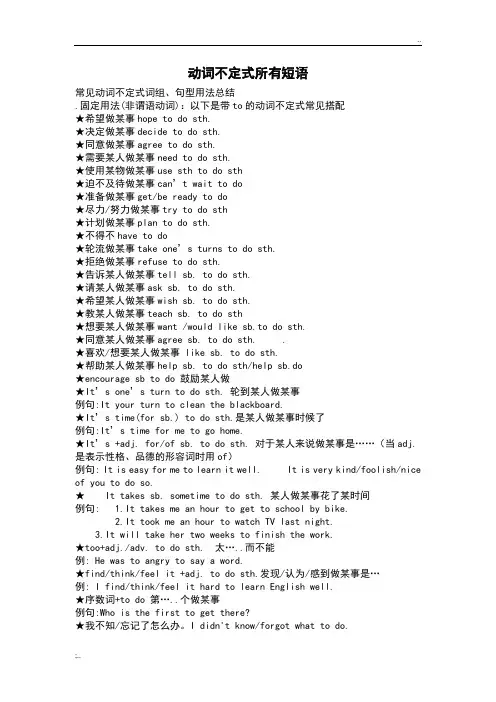
动词不定式所有短语常见动词不定式词组、句型用法总结.固定用法(非谓语动词):以下是带to的动词不定式常见搭配★希望做某事hope to do sth.★决定做某事decide to do sth.★同意做某事agree to do sth.★需要某人做某事need to do sth.★使用某物做某事use sth to do sth★迫不及待做某事can’t wait to do★准备做某事get/be ready to do★尽力/努力做某事try to do sth★计划做某事plan to do sth.★不得不have to do★轮流做某事take one’s turns to do sth.★拒绝做某事refuse to do sth.★告诉某人做某事tell sb. to do sth.★请某人做某事ask sb. to do sth.★希望某人做某事wish sb. to do sth.★教某人做某事teach sb. to do sth★想要某人做某事want /would like sb.to do sth.★同意某人做某事agree sb. to do sth. .★喜欢/想要某人做某事 like sb. to do sth.★帮助某人做某事help sb. to do sth/help sb.do★encourage sb to do 鼓励某人做★It’s one’s turn to do sth. 轮到某人做某事例句:It your turn to clean the blackboard.★It’s time(for sb.) to do sth.是某人做某事时候了例句:It’s time for me to go home.★It’s +adj. for/of sb. to do sth. 对于某人来说做某事是……(当adj.是表示性格、品德的形容词时用of)例句: It is easy for me to learn it well. It is very kind/foolish/nice of you to do so.★ It takes sb. sometime to do sth. 某人做某事花了某时间例句: 1.It takes me an hour to get to school by bike.2.It took me an hour to watch TV last night.3.It will take her two weeks to finish the work.★too+adj./adv. to do sth. 太…..而不能例: He was to angry to say a word.★find/think/feel it +adj. to do sth.发现/认为/感到做某事是…例: I find/think/feel it hard to learn English well.★序数词+to do 第…..个做某事例句:Who is the first to get there?★我不知/忘记了怎么办。
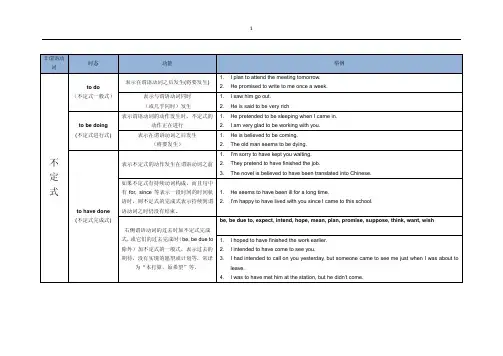
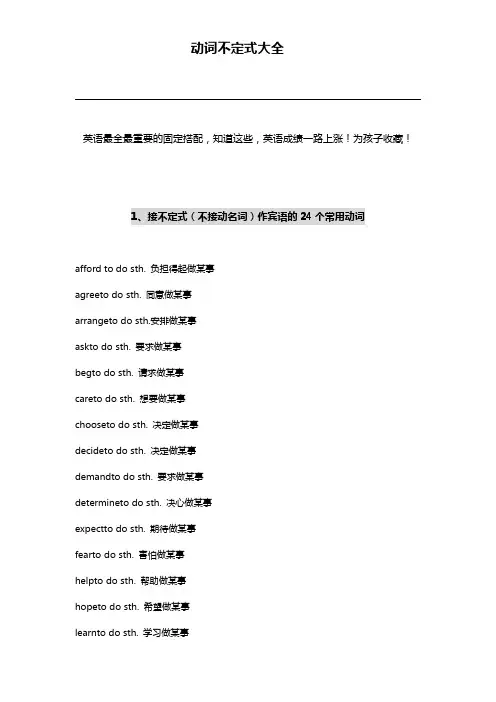
动词不定式大全英语最全最重要的固定搭配,知道这些,英语成绩一路上涨!为孩子收藏!1、接不定式(不接动名词)作宾语的24个常用动词afford to do sth.负担得起做某事agreeto do sth.同意做某事arrangeto do sth.安排做某事askto do sth.要求做某事begto do sth.请求做某事careto do sth.想要做某事chooseto do sth.决定做某事decideto do sth.决定做某事demandto do sth.要求做某事determineto do sth.决心做某事expectto do sth.期待做某事fearto do sth.害怕做某事helpto do sth.帮助做某事hopeto do sth.希望做某事learnto do sth.学习做某事manageto do sth.设法做某事offerto do sth.主动提出做某事planto do sth.计划做某事prepareto do sth.准备做某事pretendto do sth.假装做某事promiseto do sth.答应做某事refuseto do sth.拒绝做某事wantto do sth.想要做某事wishto do sth.希望做某事2、接不定式作宾补的36个常用动词advise sb.to do sth.建议某人做某事allowsb.to do sth.允许某人做某事asksb.to do sth.请(叫)某人做某事bearsb.to do sth.忍受某人做某事begsb.to do sth.请求某人做某事causesb.to do sth.导致某人做某事commandsb.to do sth.命令某人做某事drivesb.to do sth.驱使某人做某事electsb.to do sth.选举某人做某事encouragesb.to do sth.鼓励某人做某事forbidsb.to do sth.禁止某人做某事forcesb.to do sth.强迫某人做某事getsb.to do sth.使(要)某人做某事hatesb.to do sth.讨厌某人做某事helpsb.to do sth.帮助某人做某事intendsb.to do sth.打算要某人做某事invitesb.to do sth.邀请某人做某事leavesb.to do sth.留下某人做某事likesb.to do sth.喜欢某人做某事meansb.to do sth.打算要某人做某事needsb.to do sth.需要某人做某事obligesb.to do sth.迫使某人做某事ordersb.to do sth.命令某人做某事permitsb.to do sth.允许某人做某事persuadesb.to do sth.说服某人做某事prefersb.to do sth.宁愿某人做某事requestsb.to do sth.要求某人做某事remindsb.to do sth.提醒某人做某事teachsb.to do sth.教某人做某事tellsb.to do sth.告诉某人做某事trainsb.to do sth.训练某人做某事wantsb.to do sth.想要某人做某事warnsb.to do sth.警告某人做某事wishsb.to do sth.希望某人做某事3、接动名词(不接不定式)作宾语的34个常用动词admit doing sth.承认做某事advisedoing sth.建议做某事allowdoing sth.允许做某事appreciatedoing sth.感激做某事avoiddoing sth.避免做某事considerdoing sth.考虑做某事delaydoing sth.推迟做某事denydoing sth.否认做某事discussdoing sth.讨论做某事dislikedoing sth.不喜欢做某事enjoydoing sth.喜爱做某事escapedoing sth.逃脱做某事excusedoing sth.原谅做某事fancydoing sth.设想做某事finishdoing sth.完成做某事forbiddoing sth.禁止做某事forgivedoing sth.原谅做某事giveup doing sth.放弃做某事imaginedoing sth.想象做某事keepdoing sth.保持做某事mentiondoing sth.提及做某事minddoing sth.介意做某事missdoing sth.错过做某事pardondoing sth.原谅做某事permitdoing sth.允许做某事practicedoing sth.练习做某事preventdoing sth.阻止做某事prohibitdoing sth.禁止做某事putoff doing sth.推迟做某事reportdoing sth.报告做某事riskdoing sth.冒险做某事stopdoing sth.停止做某事suggestdoing sth.建议做某事understanddoing sth.理解做某事4、接现在分词作宾补的20个常用动词bring sb.doing sth.引起某人做某事catchsb.doing sth.碰上(撞上)某人做某事discoversb.doing sth.发现某人做某事feelsb.doing sth.感觉某人做某事findsb.doing sth.碰上(撞上)某人做某事getsb.doing sth.使某人做某事havesb.doing sth.使某人做某事hearsb.doing sth.听见某人正在做某事keepsb.doing sth.使某人不停地做某事listento sb.doing sth.听某人正在做某事lookat sb.doing sth.看着某人做某事noticesb.doing sth.注意到某人做某事observesb.doing sth.观察某人做某事preventsb.doing sth.阻止某人做某事seesb.doing sth.看见某人做某事sendsb.doing sth.使某人(突然)做某事setsb.doing sth.使(引起)某人做某事startsb.doing sth.使某人开始做某事stopsb.doing sth.阻止某人做某事watchsb.doing sth.观察某人正在做某事5、接动词原形作宾补的11个常用动词feel sb.do sth.感觉某人做了某事havesb.do sth.使某人做某事hearsb.do sth.听见某人做某事letsb.do sth.让某人做某事listento sb.do sth.听着某人做某事lookat sb.do sth.看着某人做了某事makesb.do sth.使某人做某事noticesb.do sth.注意某人做了某事observesb.do sth.观察某人做了某事seesb.do sth.看见某人做了某事watchsb.do sth.观察某人做了某事6、接不定式或动名词作宾语意思相同的12个动词liketo do sth/like doing sth.喜欢做某事loveto do sth/love doing sth.喜欢做某事hateto do sth/hate doing sth.憎恨做某事preferto do sth/prefer doing sth.宁可做某事beginto do sth/begin doing sth.开始做某事continueto do sth/continue doing sth.继续做某事can’t bear to do sth/can’t bear doing sth.不能忍受做某事botherto do sth/bother doing sth.麻烦做某事intendto do sth/intend doing sth.打算做某事attemptto do sth/attempt doing sth.试图做某事ceaseto do sth/cease doing sth.停止做某事7、接不定式或动名词作宾语意思不同的7个动词(1)remember to do sth.记住要做某事rememberdoing sth.记住曾做过某事(2)forget to do sth.忘记要做某事forgetdoing sth.忘记曾做过某事(3)regret to do sth.后悔(遗憾)要做某事regretdoing sth.后悔(遗憾)曾做过某事(4)try to do sth.努力去做某事trydoing sth.尝试做某事(5)mean to do sth.打算做某事meandoing sth.意味着做某事(6)can’t help to do sth.不能帮助做某事can’t help doing sth.禁不住做某事(7)go on to do sth.做完某事后接着做另一事goon doing sth.继续做一直在做的事8、可接双宾语的38个常用动词(1)双宾语易位需借助介词to的常用动词awardsb.sth.=award sth.to sb.颁奖给某人bringsb.sth.=bring sth.to sb.把某带给某人handsb.sth.=hand sth.to sb.把某物递给某人lendsb.sth.=lend sth.to sb把某物借给ailsb.sth.=mail sth.to sb把某物寄给某人offersb.sth.=offer sth.to sb.将某物给某人owesb.sth.=owe sth.to sb.欠某人某物passsb.sth.=pass sth.to sb.把某物递给某人paysb.sth.=pay sth.to sb.付给某人钱postsb.sth.=post sth.to sb.把某物寄给某人readsb.sth.=read sth.to sb把某物读给某人听returnsb.sth.=return sth.to sb.把某物还给某人sendsb.sth.=send sth.to sb.把某物送给某人sellsb.sth.=sell sth.to sb.把某物卖给某人servesb.sth.=serve sth.to sb拿某物招待某人showsb.sth.=show sth.to sb把某物给某人看takesb.sth.=take sth.to sb把某物带给某人teachsb.sth.=teach sth.to sb.教某人某事tellsb.sth.=tell sth.to sb.告诉某人某事throwsb.sth.=throw sth.to sb把某物扔给某人writesb.sth.=write sth.to sb.给某人写某事(2)双宾语易位时需借助介词for的常用动词booksb.sth.=book sth.for sb.为某人预定某物buysb.sth.=buy sth.for sb.为某人买某物choosesb.sth.=choose sth.for sb.为某人选某物cooksb.sth.=cook sth.for sb.为某人煮某物drawsb.sth.=draw sth.for sb.为某人画某物fetchsb.sth.=fetch sth.for sb.为某人去取某物findsb.sth.=find sth.for sb.为某人找到某物fixsb.sth.=fix sth.for sb.为某人准备某物getsb.sth.=get sth.for sb.为某人拿来某物makesb.sth.=make sth.for sb.为某人做某物ordersb.sth.=order sth.for sb为某订购某物picksb.sth.=pick sth.for sb.为某人采摘某物preparesb.sth.=prepare sth.for sb.为某人准备某物savesb.sth.=save sth.for sb.为某人留某物singsb.sth.=sing sth.for sb.为某人唱歌sparesb.sth.=spare sth.for sb为某人让出某物stealsb.sth.=steal sth.for sb.为某人偷某物9、可用于“动词+sb+of sth”的8个常见动词accusesb.of sth.控告某人犯某事(罪),指责某人做某事cheatsb.fo sth.骗取某人某物curesb.of sth.治好某人的病,改掉某人的坏习惯informsb.of sth.通知某人某情况(事)remindsb.of sth.使某人想起某情况(事)ridsb.of sth.使某人摆脱某物robsb.of sth.抢劫某人的某东西warnsb.of sth.警告某人有某情况10、可用于“动词+sb+for doing sth”的8个常见动词blamesb.for doing sth.指责某人做某事criticizesb.for doing sth.批评某人做某事forgivesb.for doing sth.原谅某人做某事excusesb.for doing sth.原谅某人做某事pardonsb.for doing sth.原谅某人做某事punishsb.for doing sth.惩罚某人做某事scoldsb.for doing sth.指责(责备)某人做某事thanksb.for doing sth.感谢某人做某事11、可用于“动词+sb+into doing sth”的9个常见动词cheatsb.into doing sth.欺骗某人做某事tricksb.into doing sth.欺骗某人做某事foodsb.into doing sth.欺骗某人做某事forcesb.into doing sth.迫使某人做某事arguesb.into doing sth.说服某人做某事talksb.into doing sth.说服某人做某事terrifysb.into doing sth.威胁某人做某事frightensb.into doing sth.吓唬某人做某事persuadesb.into doing sth.说服某人做某事12、容易误用作及物动词的9个不及物词误:deal a problem正:deal with a problem处理问题误:depend sb.正:depend on sb.依靠(依赖)某人误:insist doing sth.正:insist on doing sth.坚持要做某事误:knock the door正:knock on[at]the door敲门误:operate sb.正:operate on sb.为某人做手术误:participate sth.正:participate in sth.参加某事误:refer sth.正:refer to sth.查阅(参考)某物误:rely sb./sth.正:rely on sb./sth.依靠(依赖)某人(某物)误:reply a letter正:reply to a letter回信13、容易误用作不及物动词的8个及物动词误:serve for sb.正:serve sb.为某人服务误:marry with sb.正:marry sb.与某人结婚误:discuss about sth.正:discuss sth.讨论某事误:mention about sth.正:mention sth.提到某事误:enter into a room 正:enter a room进入房间误:contact with sb.正:contact sb.与某人联系误:equal to sth.正:equal sth.等于某物误:ring to sb.正:ring sb.给某人打电话。

动词不定式构成:to+ do(动词原形)否定式:not to+do 动词原形动词不定式特点:动词不定式没有人称和数的变化,在句子中不能独立作谓语。
可以在句子中作主语、宾语、表语、宾语补足语、定语、状语.一. 带to的不定式结构1. 我们学过的能直接跟带to的不定式结构的动词主要有:want, ask, tell, hope, learn, try, decide, forget, remember, like , love, stop, go, come等。
二. 不带to的不定式结构以下几种情况使用不带to的动词不定式:1. 在固定词组had better之后。
注意:had better的否定形式是had better not do sth.。
例如:You had better go home now. 你最好现在回家。
It's cold outside. You’d better not go out. 外面很冷,你最好不要出去。
2. 在let, make, see, feel, watch, hear等感官或使役动词后,要跟不带to的动词不定式作宾语补足语。
例如:I made them give me the money back. 我迫使他们把钱还给我。
I didn’t see you come in. 我没看见你进来。
3. 在引导疑问句的why not之后。
“Why not+不带to的不定式”是“Why don’t you do…”的省略,可以用来提出建议或劝告。
例如: Why not go with us? 为什么不和我们一起去呢?Why not take a holiday? =Why don’t you take a holiday? 为什么不休假呢?三.动词不定式的句法功能:(一)作主语不定式结构作主语时,现代英语倾向于采用it作形式主语,而把不定式结构后置的形式。
e.g. It’s easy (for me) to do that.我做这事太容易了。

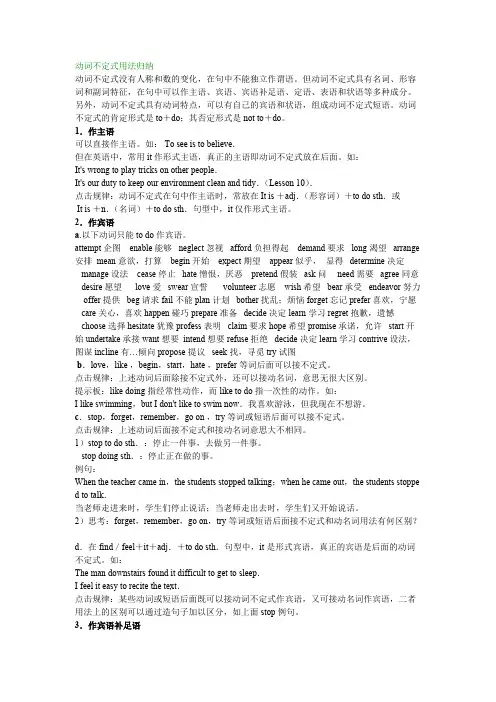
动词不定式用法归纳动词不定式没有人称和数的变化,在句中不能独立作谓语。
但动词不定式具有名词、形容词和副词特征,在句中可以作主语、宾语、宾语补足语、定语、表语和状语等多种成分。
另外,动词不定式具有动词特点,可以有自己的宾语和状语,组成动词不定式短语。
动词不定式的肯定形式是to+do;其否定形式是not to+do。
1.作主语可以直接作主语。
如: To see is to believe.但在英语中,常用it作形式主语,真正的主语即动词不定式放在后面。
如:It's wrong to play tricks on other people.It's our duty to keep our environment clean and tidy.(Lesson 10).点击规律:动词不定式在句中作主语时,常放在It is +adj.(形容词)+to do sth.或It is +n.(名词)+to do sth.句型中,it仅作形式主语。
2.作宾语a.以下动词只能to do 作宾语。
attempt企图 enable能够 neglect忽视 afford负担得起 demand要求 long渴望 arrange 安排 mean意欲,打算 begin开始 expect期望 appear似乎,显得 determine决定manage设法 cease停止 hate憎恨,厌恶 pretend假装 ask问 need需要 agree同意 desire愿望 love爱 swear宣誓 volunteer志愿 wish希望 bear承受 endeavor努力 offer提供 beg请求 fail不能 plan计划 bother扰乱;烦恼 forget忘记 prefer喜欢,宁愿 care关心,喜欢 happen碰巧 prepare准备 decide决定 learn学习 regret抱歉,遗憾choose选择 hesitate犹豫 profess表明 claim要求 hope希望 promise承诺,允许 start开始 undertake承接 want想要 intend想要 refuse拒绝 decide决定 learn学习 contrive设法,图谋 incline有…倾向 propose提议 seek找,寻觅 try试图b.love,like ,begin,start,hate ,prefer等词后面可以接不定式。
史上最全的英语动词不定式(建议收藏)1、基础知识清单不定式有俩种表现方式,一种是带to的不定式,一种是省略to的不定式。
不定式不能做谓语,但它具有动词的一些特征,如可以带有自己的宾语、状语、及逻辑主语等。
它没有人称和数的变化,但有时态和语态的变化。
2、考点分类剖析考点一:动词不定式的时态1) 一般式(to do):表示的动作或状态与谓语动词表示的动作同时发生或在其后后发生,如: E.g. I want to have a holiday as soon as possible. He seems to know the secret.2) 完成式(to have done):表示的动作在谓语动词表示的动作之前就发生了E.g. I am sorry to have given you so much trouble.3) 进行式(to be doing):表示或者强调其动作与谓语动词表示的动作同时发生E.g. This city seems to be getting more and more crowded.4) 完成进行式(to have been doing ):表示的动作在谓语动词表示的动作之前已经发生,并仍在进行,而且还可能继续下去E.g. Tom seems to have been watching TV for a long time.考点二:动词不定式的语态1) 当不定式逻辑上的主语是这个不定式所表示的动作的承受者时,不定式要用被动形式(to be done) E.g. He asked to be sent to work in the countryside.2) 不定式修饰的名词或代词和不定式逻辑上构成主谓关系时,不定式用主动形式,如:E.g. Have you got a key to unlock the door?3) 不定式前面的名词或代词与不定式构成逻辑上的动宾关系,但又与该句的主语构成逻辑上的主谓关系的时候,不定式常用主动形式,如: E.g. I have got a letter to write. He needs a room to live in.4) 不定式作表语形容词的状语,和句子中的主语构成逻辑上的动宾关系时,不定式多用主动形式,如E.g. The book is difficult for us to understand.5) 如果强调句中动作的承受者时,亦可用不定式的被动式,上面的句子可以写成: E.g. The book is difficult for us to be understood.考点三:动词不定式的句法功能由于动词不定式具有名词、形容词和副词的特征,所以动词不定式在句中可以作主语、表语、宾语、定语、状语和补语。
初中英语常用动词不定式短语整理(To do)1.want (sb.) to do sth.想让(某人)做某事2.would like to do sth. 想让做某事3.try one’s best to do sth. 尽某人做大努力做某事4.Expect sb. To do sth,期望某人做某事5.can`t wait to do sth. 迫不及待的做某事6.plan to do sth.计划做某事7.ask sb. to do sth. 让某人做某事8.ask sb. not to do sth.9.tell sb. to do sth.告诉某人做某事10.tell sb. not to do sth.11.invite sb. to do sth. 邀请某人做某事12.be sure to do sth.确信做某事13.It’s time (for sb.)to do sth.到了(某人)做某事的时间了14.be supposed to do sth. 应该做某事15.encourage sb. to do sth. 鼓励某人做某事16.decide to do sth. 决定做某事17.make one`s mind to do sth.18.fear to do sth. 害怕做某事19.be going to do sth.打算做某事20.It’s adj. (for sb.)to do sth. 做某事对(某人)怎么样21.It’s adj. (of sb.)to do sth. 某人做某事怎么样22.be surprised to do sth. 做某事感到惊讶ed to do sth. 过去常常做某事24.be able to do sth. 会做某事25.wish sb. to do sth. 希望某人做某事26.hope to do sth. 希望做某事27.pretend to do sth. 假装做某事28.have an opportunity to do sth. 有做某事的机会29.lead to do sth. 引导做某事30.make a decision to do sth. 决定做某事31.in order to do sth. 为了做某事32.go out of one`s way to do sth.特地(不怕麻烦地)做某事33.be willing to do sth. 心甘情愿做某事34.It’s one’s turn to do sth.轮到某人做某事35.warn sb. to do sth. 提醒某人做某事36.warn sb. not to do sth.37.too…to do 太…..而不能….38.It takes sb some time to do sth.花费某人多少时间做某事39.learn to do 学做某事40.begin/start to do sth. 开始做某事41.allow sb. to do sth. 允许某人做某事42.(old) enough to do sth.足够...做某事43.begin/start to do sth.=begin/start doing sth.(没有太大区别)44.continue to do sth.=continue doing sth.(没有太大区别)45.prefer to do sth=. prefer doing sth.更愿意做某事(没有太大区别)46.want (sb.) to do sth. =would like( sb.) to do sth.想让某人(不)做某事47.choose to do sth. 选择做某事48.tell sb. (not) to do sth. 告诉某人(不)做某事49.ask sb. (not) to do sth. 请求、叫某人(不)做某事50.decide to do sth . 决定做某事51.expect to do sth. 期待做某事52.fail to do sth. 没能做成某事53.hate to do sth.=hate doing sth.(没有太大区别)54.help sb.(to) do sth. 帮助某人做某事55.hope to do sth. 希望做某事56.wish (sb.) to do sth. 希望做某事57.learn to do sth. 学习做某事58.teach sb. to do sth. 教某人做某事59.manage to do sth. 设法做成某事60.need to do sth. 需要做某事(needn't do sth. =don't have to dosth. 不必做某事need doing sth. = need to be done 需要被。
常见动词不定式词组、句型用法总结★希望做某事hope to do sth.★决定做某事decide to do sth.★同意做某事agree to do sth.★需要某人做某事need to do sth.★使用某物做某事use sth to do sth★迫不及待做某事can’t wait to do★准备做某事get/be ready to do★尽力/努力做某事try to do sth★计划做某事plan to do sth.★不得不have to do★轮流做某事take one’s turns to do sth.★拒绝做某事refuse to do sth.★告诉某人做某事tell sb. to do sth.★请某人做某事ask sb. to do sth.★期待某人做某事expect sb. to do sth.★教某人做某事teach sb. to do sth★想要某人做某事want /would like sb.to do sth.★同意某人做某事agree sb. to do sth..★喜欢/想要某人做某事like sb. to do sth.★帮助某人做某事help sb. to do sth/helpsb.do★It’s one’s turn to do sth. 轮到某人做某事★It’s time(for sb.) to do sth.是某人做某事时候了★It’s +adj. for/of sb. to do sth. 对于某人来说做某事是……★It takes sb. time to do sth. 某人做某事花了某时间以下是不带to的动词不定式(即动词原形)的常见用法★let sb. do sth让某人做某事★make do sth使得某人做某事★hear do sth do sth听见某人做某事★see do sth do sth看见某人做某事★why not 或why don’t you +动词原形?为什么不….?(表示建议)★某人+had better( not)do 某人最好(不)做某事★情态动词can/may /must /should+ 动词原形(包括情态动词的否定形式+动词原形)★be going to + 动词原形(表示“即将”“打算”做某事)5.在以下结构中加ing1.enjoy doing sth喜欢做某事;2.finish doing sth;完成做某事;3.feel like doing sth 想要做某事;4.stop doing sth停止做某事(原来的事)5.forget doing sth忘记做过某事;6.go on doing sth继续做某事(原来的事);7.remember doing sth 记得做过某事;8.like doing sth喜欢做某事;9.find /see/hear/watch sb doing发现/看到/听到/观看某人做10.try doing sth试图做某事;11.need doing sth需要做某事;12.prefer doing sth 宁愿做某事;13.mind doing sth 介意做某事;14.miss doing sth 错过做某事;15.practice doing sth 练习做某事;16.be busy doing sth 忙于做某事;17.can't help doing sth禁不住做某事;18. waste time/money doing 浪费时间/金钱做…;19. keep sb.doing 让…始终/一直做…阻止某人做某事20. stop sb.(from)doing21. prefer doing a to doing b=like A better than b短语22. “do some +doing”如:do some shopping/do some washing/do some reading/do some practicing/do some cleaning/do some speaking短语去做某事(主要指文娱活动等)23.“go doing”如:go shopping/go fishing/go swimming/go hiking/go skating/go camping/go skiing(滑雪/go boating /go hunting (打猎)。
动词不定式的归纳总结动词不定式是由“to+动词原形”构成的,否定形式为“not to+动词原形”构成的,这里的to没有词义,只是为了构成不定式的一种符号,是非谓语动词形式的一种,动词不定式在句中不能独立作谓语,除了不能作谓语以外,其他成分都可以作,因此,在句中可以作主语、表语、宾语、定语、状语和补足语。
❶ 动词不定式做主语:这种情况一般要改成it作形式主语的形式,后接不定式,为了避免头重脚轻。
●“It is+形容词+for sb.+to do sth.”意为“做某事对某人来说是…的”中句中的形容词多为描述性的词语,不对人或物的品格进行评价,如difficult, easy, hard, inportant, dangerous, inpossible等。
eg To learn English is very important for me 对我来说学英语很重要。
=It is very important for me to learn English.For you to make more friends is a good plan. 广交朋友是个好办法。
= It's a good plan for you to make more friends.●“It is+形容词+of sb.+to do sth.”意为"做某事对某人来说是…的”。
其中句中的形容词用于描述人的性格、品质, 如:kind, good, nice, right, wrong, clever, careless, polite, foolish 等。
eg It was stupid of him to press the emergency button. 他按了紧急按钮,这真愚蠢。
❷ 本单元我们主要学习动词不定式作宾语的用法:现就动词不定式作宾语的用法介绍如下:●谓语动词+动词不定式,此类动词很多,常见的有:want, like, wish, hate, prefer, hope, continue, manage, try, ask, offer(主动提出), start, forget, promise, mean, pretend(假装), intend(打算), begin, attempt(试图), decide, learn, desire (渴望), agree, care, choose, determine(查明), undertake(承担,承诺),expect 等eg Some students hate to study English. 有些学生不喜欢研读英语。
初中动词不定式集锦(重要必背)Doingfinish doing sth.做完某事be busy doing sth.忙于做某事be good at doing sth.擅长做某事do well in doing sth. 擅长做某事mind doing sth.介意做某事how about doing sth. 做某事怎么样what about doing sth.practice doing sth. 练习做某事find sb. doing sth. 发现某人在做某事spend (in) doing sth. 做某事花费多少钱(时间)have fun (in) doing sth.做某事很高兴be interested in doing sth 做某事感兴趣enjoy doing sth. 喜欢做某事thanks for doing sth. 感谢某人做某事(can`t) stand doing sth. (不能)忍受做某事have difficulty/trouble doing sth 做某事有困难/麻烦be against doing 反对做某事consider doing =think about doing sth.考虑做某事be worth doing sth. 值得做某事prefer doing to doing 比起做某事更喜欢做某事keep sb.doing sth 使某人一直做某事(keep sth adj )feel like doing 想做某事be /get used to doing sth习惯于做某事have a hard/difficult time doing sth.做某事吃力make a living(by) doing sth.依靠做……谋生look forward to doing sth. 期盼做某事Stop sb (from) doing 阻止某人做某事end up doing sth 以做......而结束(end up with sth)Can`t help doing sth.禁不住做某事have experience doing 做某事有经验appreciate doing sth.感激做某事miss doing sth. 错过做某事Dowould you please do sth. 你做…好吗let sb. do sth.让某人做某事make sb. do sth. 让某人做某事have sb. do sth.让某人做某事had better do sth.最好做某事had better not do sth. 最好别做某事why not do sth.= why don`t you do sth.为什么不做某事would rather do…than do…宁愿做……不愿做……To dowant (sb.) to do sth.想让(某人)做某事would like to do sth. 想让做某事try one’s best to do sth. 尽某人做大努力做某事Expect sb. To do sth,期望某人做某事can`t wait to do sth. 迫不及待的做某事plan to do sth.计划做某事ask sb. to do sth. 让某人做某事ask sb. not to do sth.tell sb. to do sth.告诉某人做某事tell sb. not to do sth.invite sb. to do sth. 邀请某人做某事be sure to do sth.确信做某事It’s time (for sb.)to do sth.到了(某人)做某事的时间了be supposed to do sth. 应该做某事encourage sb. to do sth. 鼓励某人做某事decide to do sth. 决定做某事make one`s mind to do sth.fear to do sth. 害怕做某事be going to do sth.打算做某事It’s adj. (for sb.)to do sth. 做某事对(某人)怎么样It’s adj. (of sb.)to do sth. 某人做某事怎么样be surprised to do sth. 做某事感到惊讶used to do sth. 过去常常做某事be able to do sth. 会做某事wish sb. to do sth. 希望某人做某事hope to do sth. 希望做某事pretend to do sth. 假装做某事have an opportunity to do sth. 有做某事的机会lead to do sth. 引导做某事make a decision to do sth. 决定做某事in order to do sth. 为了做某事go out of one`s way to do sth.特地(不怕麻烦地)做某事be willing to do sth. 心甘情愿做某事It’s one’s turn to do sth.轮到某人做某事warn sb. to do sth. 提醒某人做某事warn sb. not to do sth.too…to do 太…..而不能….It takes sb some time to do sth.花费某人多少时间做某事learn to do 学做某事begin/start to do sth. 开始做某事allow sb. to do sth. 允许某人做某事(old) enough to do sth.足够...做某事两者都有(Doing Do To do)help sb. do/to do sth. 帮助某人做某事love to do/doing sth. 喜欢做某事like to do/doing sth. 喜欢做某事hate to do/doing sth.讨厌做某事see sb. do/doing sth.看见某人做了某事/在做某事notice/watch sb. do/doing sth. 看见某人做了某事/在做某事hear sb. do/doing sth. 听见某人做了某事/在做某事start/begin to do/doing sth.开始做某事remember to do/doing sth.记住做某事(未做)/(已做)forget to do/doing sth. 忘记做某事(未做)/(已做)stop to do/doing sth. 停下来去做某事/停止做某事prefer to do…than do…宁愿做某事……不愿做某事need to do (主动)/doing(被动) 需要做某事。
英语动词不定式大全 动词不定式是一种活跃的非谓语动词。
它在句中起的是名词。
形容词或副词的作 用, 可在句子中作主语。
宾语。
定语。
状语和宾语补足语。
动词不定式的形式是 "to + 动词原形 ", 但 to 有时要省去。
动词不定式在具体运用时 , 用不用 to, 取决 于谓语动词的用法 :一。
带 to 的不定式结构1. 我们学过的能直接跟带 to 的不定式结构的动词主要有 :want, ask, tell, hope, learn, try, decide, forget, remember, like ,love, stop, go, come 等。
2. 动词不定式的否定形式是在不定式前直接加 not, 即 not to do sth. 。
例 如: Jim told me not to wake up Kate. 吉姆告诉我别叫醒凯特。
二。
不带 to 的不定式结构以下几种情况使用不带 to 的动词不定式 :1. 在固定词组had better 之后。
注意:had better 的否定形式是had better not do sth. 。
例如 :You had better go home now. 你最好现在回家。
It's cold outside. You'd better not go out. 外面很冷 , 你最好不要出去。
2. 在 let,make,see, feel, watch,hear 等感官或使役动词后 , 要跟不带 to 的动词不定式作宾语补足语。
例如 :I made them give me the money back. 我迫使他们把钱还给我。
I didn't see you come in. 我没看见你进来。
3. 在引导疑问句的 why not 之后。
"Why not+不带to 的不定式"是 Why don't you do …的省略,可以用来提出 建议或劝告。
英语动词不定式大全
动词不定式是一种活跃的非谓语动词。
它在句中起的是名词。
形容词或副词的作用,可在句子中作主语。
宾语。
定语。
状语和宾语补足语。
动词不定式的形式是"to +动词原形",但to有时要省去。
动词不定式在具体运用时,用不用to,取决于谓语动词的用法:
一。
带to的不定式结构
1.我们学过的能直接跟带to的不定式结构的动词主要有:want, ask, tell, hope, learn, try, decide, forget, remember, like ,love, stop, go, come 等。
2.动词不定式的否定形式是在不定式前直接加not,即not to do sth.。
例如:
Jim told me not to wake up Kate.吉姆告诉我别叫醒凯特。
二。
不带to的不定式结构
以下几种情况使用不带to的动词不定式:
1.在固定词组had better之后。
注意:had better的否定形式是had better not do sth.。
例如:
You had better go home now.你最好现在回家。
It's cold outside. You'd better not go out.外面很冷,你最好不要出去。
2.在let,make,see, feel, watch,hear等感官或使役动词后,要跟不带to 的动词不定式作宾语补足语。
例如:
I made them give me the money back.我迫使他们把钱还给我。
I didn't see you come in.我没看见你进来。
3.在引导疑问句的why not之后。
"Why not+不带to的不定式"是Why don't you do…的省略,可以用来提出建议或劝告。
例如:
Why not go with us。
为什么不和我们一起去呢。
Why not take a holiday。
=Why don't you take a holiday。
为什么不休
个假呢。
三。
动词不定式作主语
不定式结构作主语时,现代英语倾向于采用it作形式主语,而把不定式结构后置的形式。
参见本期本面《"小鬼it"它当家》中it作形式主语的用法。
四。
动词不定式作定语
不定式作定语,要放在它所修饰的名词或代词的后面。
例如:
I have nothing to say on this question.对这个问题我无可奉告。
五。
动词不定式作宾语
有的及物动词要求跟复合宾语(即宾语+宾语补足语)。
如果其中的宾语是不定式短语,则必须将形式宾语it放在宾语的位置上,而将不定式短语(真正的宾语)放在宾语补足语之前。
例如:
I find it useful to learn English well.我发现学好英语很有用。
We thought it wrong not to tell her.我们认为不告诉她是错误的。
六。
动词不定式作宾语补足语
动词不定式作宾语补足语是动词不定式用法的一个重点,学习时要注意以下三种情况:
1.作动词ask, like, tell等的宾语补足语时,动词不定式符号to不可以省略。
例如:
He asked me to talk about English study.他请我谈谈英语学习。
2.作使役动词let, have, make以及感官动词feel, hear, see, watch等的宾语补足语时,动词不定式符号to要省略。
例如:
The teacher made him say the word like this.老师让他像这样说这个单词。
3.作动词help的宾语补足语时,动词不定式符号to可以带,也可以不带。
例如:
Could you help me (to) carry the heavy box。
你能帮我搬这个重箱子吗。
七。
动词不定式作状语
动词不定式及其短语具有副词的特性,可在句中用作状语。
1.放在句首也可以放在句尾表示目的等。
例如: He stopped to have a rest.他停下来休息。
2.跟在作表语的形容词或过去分词的后面。
例如:
I'm sorry to hear that.听到这事我感到很难过。
3.用在too... to...结构中。
例如:
He is too young to understand all that.他太年轻了,不能理解这件事
有些动词后面跟to do和动词-ing形式所表达的意思不同。
这类动词有:remember,forget,regret, try,mean,go on, stop等。
如:
I told him of the matter again,for I forgot having met him after the accident.
Don‘t forget to lock the door. It is not safe enough here.
① try to do “努力做某事” try doing “尝试做某事”
He tried to work out the problem.
He tried working out the problem in another way.
② mean to do “打算做某事” mean doing “意味着”
What! Did you mean to leave by train?
Missing the train means waiting for an hour.
③ regret to do 因没做某事而遗憾,抱歉 regret doing 因做过某事而遗憾,后悔
I regret to say I can‘t help you.
I regret saying such silly words.
④ go on to do 继续另外一件事 go on doing 继续同一件事
⑤stop to do 停下去做另外一件事 stop doing停下正在做的事
⑥ prefer
I prefer reading to going shopping on weekends.
I would prefer to spend the weekend at home rather than drive.
⑦ allow, advise, forbid, permit
Sorry, we don’t allow smoking in the lecture room.
We don’t allow people to smoke here. I wouldn’t advise taking the car --- there’s nowhere to park.
I wouldn’t advise you to take the car.
need,want,require,deserve
need to be done= need doing。